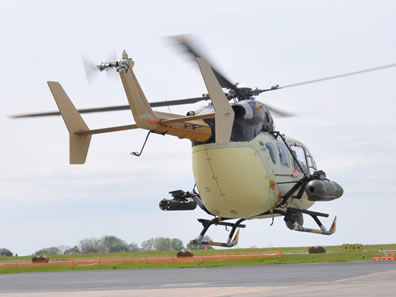
EADS North America unveiled the company funded Armed Aerial Scout 72X (AAS-72X) helicopter in flight demonstrations held at the Nashville International Airport, coinciding with the recent Army Aviation convention held at the city’s convention center at that time. The industry team promoting the AAS-72X includes American Eurocopter, an EADS USA company and Lockheed Martin (NYSE: LMT). Investing in the development and flight demonstration of three AAS-72X Technical Demonstrator Aircraft (TDA) as part of the team’s developmental and risk reduction activities, the program highlights the maturity of AAS-72X, based on the commercial EC145 helicopter platform.


TDA-1 presented at the Nashville Airport was equipped with a full Mission Equipment Package (MEP) including a chin-mounted Multi-Spectral Targeting System (MTS), made by Raytheon, communications suite and weapons. A similar platform from Eurocopter UAS, the H-72A Lakota has already deployed with Army National Guard Security and Support Battalions with similar multi-sensor payloads. The helicopter demonstrated the multi-purpose pylons, designed to accommodate the full range of precision and unguided munitions expected to be required by the Army for the Armed Scout. Weapon loads demonstrated at Nashville comprised a multi-purpose pylon carrying an HMP 400 heavy machine gun pod fitted with a 50-caliber M3P machine gun loaded with 400-rounds of ammunition and a M260 seven-shot rocket launcher, firing 2.75-inch folding fin aerial rockets.
The Armed Scout was equipped with manned-unmanned teaming capability, advanced avionics and 3 axis auto-pilot. The helicopter features modern avionics include the instrument panel’s Vehicle and Engine Management Display (VEMD), which aids pilots in integrating and synthesizing flight and vehicle information – increasing situational awareness and reducing pilot workload.
The TDA-1 made its first flight in December 2010, and is being used to validate the AAS-72X’s ability to meet the U.S. Army’s current armed aerial scout mission requirements. Prior to first flight of the TDA helicopter, the company conducted high/hot hover-out-of-ground-effect, endurance and payload testing in 2009 at Alamosa, Colo., successfully operating at 6,000 feet and 95-degree density altitude. The team also conducted a key transportability test when five militarized EC145 aircraft were successfully loaded in a C-17 transport aircraft. Additionally, EADS North America and Lockheed Martin established a System Integration Laboratory (SIL) and hangar in April 2010 at Lockheed Martin’s Orlando, Fla. facility.
Among the AAS-72X advantages is the twin-engine safety, ample energy reserves for high/hot operating performance, considered critical to the Army’s Armed Scout mission.
If Eurocopter wins the Army scout program, AAS-72X production will co-locate with te UH-72A Lakota production line at American Eurocopter’s Columbus, Miss. This line has delivered more than 160 UH-72A Lakotas to the U.S. Army along with five H-72A versions to the U.S. Navy for test pilot training.




















